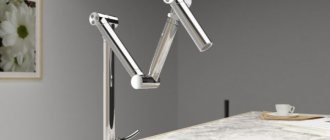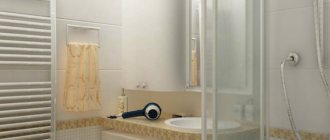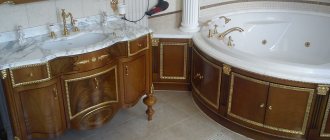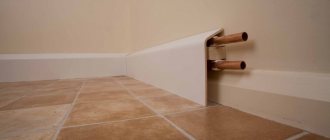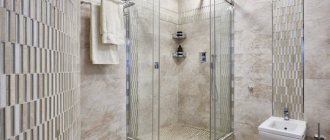Problems with hot water supply occur in almost every home. Therefore, you often want to have your own water heater in the bathroom so as not to experience any unpleasant surprises. But with what and how to heat water in the bathroom is a question that requires careful and detailed discussion.
Types, types of water heaters, functionality of designs, installation and placement in the bathroom - these are the issues that need to be resolved before purchasing water heaters for the bathroom. But everything is in order.
Types of water heaters
Water heaters are divided into gas and electric . The first are called “columns”; they provide rapid heating of running water and are suitable for a private home, but their installation requires effective ventilation. Systems powered by electricity can be used in apartment buildings. Their installation does not need to be coordinated with utility services. Such water heaters are instantaneous or storage.
Cumulative
The boiler is equipped with a container in which cold water is accumulated and heated. These devices consume a minimal amount of electricity and allow you to have a supply of heated liquid. The main disadvantage of the device is its dimensions, which limit possible installation options. The devices differ in design and technical characteristics. When choosing a boiler, pay attention to the service life. It depends on the type of heating element - heating coil.
By design, boilers are divided into the following types:
- With dry heating element. In this case, the heating element does not come into contact with water.
- With a wet heating element. The heating coil comes into contact with the liquid. The device has a shorter service life, which is explained by the rapid failure of the heating element.
Flow-through water heating systems
Flow systems are considered the most convenient option for installation in the bathroom.
There are 3 types of such water heaters:
- Stationary water heater for the bathroom.
Stationary. They are installed as a separate element, which is explained by their dimensions. The device is placed under the sink or bathtub. The first is equipped with a decorative cabinet that hides the heating system. - Mixer attachment. The universal device is placed on the tap tube in front of the swivel spout. Such a device is suitable for washing or washing dishes. A small heater cannot provide water supply for taking a shower or bath.
- Electrically heated faucet. A modern heating device has a separate mixer. The principle of operation is no different from that of nozzles. The heating rate depends on the pressure in the pipeline. The system can be used in the absence of hot water supply. You won't be able to take a bath; the water gets cold quickly. For a shower stall, a heated faucet is considered a good option. The system can be installed with your own hands; it consumes a small amount of electricity.
Additional useful features
In addition to the main function - providing housing with hot water, modern boilers can have additional functionality that makes life easier:
- Remote control. In order not to overload the front panel of the boiler with unnecessary controls, some of the buttons are placed on the remote control.
- Control from a smartphone. The remote control may get lost in the vastness of the house, but a modern person always has a smartphone at hand and also provides access to additional functions and parameters of the water heater.
- Possibility of programming the operation of the device for a period. This is useful in cases of differentiated electricity tariffs or the need for the water heater to be ready, for example, by the time you arrive from work.
Choosing an installation location
The easiest way is to install a boiler near a branch of the water supply system in the area between the riser and the plumbing fixture. The water heater can be left in the kitchen, bathroom, or toilet. Less commonly, the device is installed in corridors.
The modern design of the device does not require camouflage. However, most owners of houses and apartments hide water heaters in boxes, niches or cabinets.
Bathroom
Separate bathrooms have a large passage capacity, allowing several residents to carry out hygiene procedures at the same time.
When installing a water heater in a bathroom, consider the following points:
- The room most often has a minimum area (no more than 4 m²).
- Due to the lack of free space, storage water heaters are inconvenient to install.
- There are no risers for sewerage, cold water and hot water, which does not allow making a box.
- For the bath and sink use one rotary mixer or two separate taps.
- One wall is occupied by a bathtub, the other by a heated towel rail.
Combined bathroom
Combined bathroom.
A combined bathroom is present in Khrushchev apartments. Hidden installation of the boiler is carried out during the renovation of secondary housing.
The drive can be installed using several methods:
- in the niche behind the toilet;
- in a box for water supply pipes;
- under the washbasin in the cabinet;
- in the closet above the washing machine or toilet;
- on the mezzanine above the door.
When using the last two methods, connecting the device to the pipeline causes difficulties. Violation of the tightness of connections leads to damage to furniture or household appliances.
Toilet
The toilet is the smallest room in the apartment; in a private house, a large area is allocated for this room. Plumbing fittings, metering devices, and water supply risers are located here. The project includes a niche located behind the toilet, or a box for masking pipes. These structures are used to hide the water heater.
The boiler installed in a niche is decorated with blinds. Other options when placing the device in the toilet are not used.
What do you need to know about the gas water heater?
Houses with a gas water heater are predominantly of the “old stock” - they often want to remodel them, connect a room with a kitchen, or simply enlarge the kitchen at the expense of adjacent rooms, such as a corridor.
And here difficulties arise - since combining gasified kitchens with living rooms is prohibited due to fire safety rules. Moreover, even with moving the speaker into the kitchen itself, difficulties can arise - and their degree depends on how far you are going to “remove” the speaker.
If the chimney remains very close, a report on its condition and approval from the gas service will be required. If the column is moved more than 1.5 meters, you will have to draw up a transfer report. These procedures invariably delay repairs - you will have to wait several months for permission from the gas company. Be ready.
- Technique
How to choose a instantaneous gas water heater: 6 important parameters and useful tips
Connection diagrams
The installation diagram of a heater in a bathroom includes the following points:
- Water heater connection diagram.
Piping the water supply system. A connection is made into the water supply system after the riser valves. A safety valve with drainage is installed at the inlet to the heater. After this, shut-off valves are installed. There are 2 flexible tubes leading from the boiler. The drainage line is connected to the sewer. - Connection to the electrical network. In this case, installation of grounding and a circuit breaker is required. To power the device, a separate socket with a voltage of 220 V is used. The connection diagram to the electrical network can be seen in the photograph.
Preparing for installation
At the preparatory stage, the installation location is selected, tools and materials are purchased, and a connection diagram is drawn up.
To complete the work you will need the following components and additional elements:
- Plumbing, construction tools. Wrenches, pliers, a hammer drill, a set of screwdrivers, wire cutters, and a tape measure will come in handy.
- Materials for arranging a water supply system. You will need metal-plastic pipes, flexible hoses, adapters, sealing tape, tow, and shut-off valves.
- Materials for connecting the device to the electrical network. Use three-wire wires, an automatic fuse, and a socket.
Installation and connection of a water heater
There are 2 installation methods - permanent or temporary.
In the second case, perform the following actions:
- Install the Titan boiler on the wall. The distance between the device mounts is measured with a tape measure and the surface is marked. Using a hammer drill, create holes for the bolts. After installing the anchor hooks, the boiler is hung in place.
- Connect the water heating system. The cold water supply pipe is equipped with a tee. Install shut-off valves and connect the shower faucet to the boiler outlet.
The permanent installation of a instantaneous water heater is carried out so that it functions synchronously with the water supply system.
Bathroom water heater option.
To do this, perform the following steps:
- Adapters are inserted into the water line. Install shut-off valves.
- Connect the cold water supply pipe to the boiler. The connection location is marked in blue.
- The heater outlet is connected to the mixer using a metal-plastic pipe and tee.
- Check the tightness of the connections. If there is a leak, the joints are coated with sealant. If everything is done correctly, the plug of the device is inserted into the socket.
Designs for masking the boiler
Water heaters can be installed without additional decoration. It is difficult to choose a ready-made cabinet to hide such a device. The exception is devices intended for installation under the sink. Sometimes structures for masking a water heater are assembled by hand.
Box
The box is a structure protruding in relation to the wall. It is assembled from plasterboard and installed on a metal frame. Unlike a cabinet, the box is non-demountable. Instead of a door, an inspection hatch is used.
Installation of the box involves the following actions:
- Boiler installation. The device is connected to water supply and power supply systems in a standard way.
- Installation of the frame. The guide profiles are installed first, after which the front pillars are placed. The assembly of the frame is completed by fixing the stiffeners and jumpers.
- Sheathing. Drywall sheets are attached to the profiles with self-tapping screws. Surfaces are treated with water-repellent antiseptic impregnation. The outer parts of the box are tiled.
Box for masking the water heater.
Niche behind the toilet
In this case, installation of side walls is not required, which reduces repair time and consumption of building materials. The water heater in the interior is hidden using blinds. Pipes interfere with the installation of standard fasteners, so brackets are used. A stepped box is formed by building up the wall above the plumbing fixture.
Mezzanine
The mezzanine used for storing things can be turned into a niche to accommodate a water heating system. The shelf is covered with doors or curtains. A storage device is placed on it.
To make a mezzanine with your own hands, perform the following steps:
- make markings on opposite walls of the corridor;
- install bars or metal profiles;
- a shelf is placed on the frame;
- install and connect the boiler;
- install blinds.
The mezzanine is only suitable for installing horizontal devices. Vertical models cannot be laid on their sides.
Closet
A large-volume storage water heater can be hidden in a built-in closet. Water and sewer pipes are pulled through the wall separating the corridor from the bathroom. The cabinet has a simple design. The doors move along guides. No side walls required. The boiler is placed at the bottom of the furniture. The remaining space is used for storing things.
Floor stand
Due to its small size, the cabinet is not suitable for installing volumetric storage heaters. A two-door piece of furniture can accommodate a boiler with a capacity of up to 80 liters. It is installed on a shelf or mounted on the wall of the room. The back part of the cabinet is dismantled.
Water heater hidden from view.
How to decorate a column?
To make it less conspicuous, try hiding it.
Close up with kitchen set
This solution is possible, but the cabinet for the speaker should not have a bottom and top wall - it is necessary that there is free air circulation. Sometimes, in order to fulfill this decision, you have to make a set to order - with non-standard cabinet depths or heights. For example, in this kitchen the gas heater is hidden behind a false cabinet without a side wall.
Photo: Instagram belova_design
Paint it the same color as the walls
Or choose a light finish to match the color of the column. This technique will visually “dissolve” it in space. But, of course, it won’t hide it completely.
Photo: Instagram viraiva_home
Slide into a corner
Remember about approval? If you decide to move the column into a corner, you can cover it with a corner cabinet - by the way, this will solve the issue of usable space, since corner cabinets are often the most useless. Or just disguise it between the cabinets, which is also good.
Photo: Instagram kuhnivolot
Choose a boiler to match the color of the set
Now there are really stylish and aesthetic gas boilers and water heaters.
Photo: Instagram hubert_almaty

